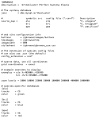Using the Generic Synteny Browser (GBrowse_syn)
- PMID: 20836076
- PMCID: PMC3162311
- DOI: 10.1002/0471250953.bi0912s31
Using the Generic Synteny Browser (GBrowse_syn)
Abstract
Genome Browsers are software that allow the user to view genome annotations in the context of a reference sequence, such as a chromosome, contig, scaffold, etc. The Generic Genome Browser (GBrowse) is an open-source genome browser package developed as part of the Generic Model Database Project (see UNIT ; Stein et al., 2002). The increasing number of sequenced genomes has led to a corresponding growth in the field of comparative genomics, which requires methods to view and compare multiple genomes. Using the same software framework as GBrowse, the Generic Synteny Browser (GBrowse_syn) allows the comparison of colinear regions of multiple genomes using the familiar GBrowse-style Web page. Like GBrowse, GBrowse_syn can be configured to display any organism, and is currently the synteny browser used for model organisms such as C. elegans (WormBase; http://www.wormbase.org; see UNIT 1.8) and Arabidopsis (TAIR; http://www.arabidopsis.org; see UNIT 1.1). GBrowse_syn is part of the GBrowse software package and can be downloaded from the Web and run on any Unix-like operating system, such as Linux, Solaris, or MacOS X. GBrowse_syn is still under active development. This unit will cover installation and configuration as part of the current stable version of GBrowse (v. 1.71).
Figures














Similar articles
-
Using the Generic Genome Browser (GBrowse).Curr Protoc Bioinformatics. 2007 Mar;Chapter 9:Unit 9.9. doi: 10.1002/0471250953.bi0909s17. Curr Protoc Bioinformatics. 2007. PMID: 18428797
-
Using the Generic Genome Browser (GBrowse).Curr Protoc Bioinformatics. 2009 Dec;Chapter 9:Unit 9.9. doi: 10.1002/0471250953.bi0909s28. Curr Protoc Bioinformatics. 2009. PMID: 19957275
-
SynBrowse: a synteny browser for comparative sequence analysis.Bioinformatics. 2005 Sep 1;21(17):3461-8. doi: 10.1093/bioinformatics/bti555. Epub 2005 Jun 30. Bioinformatics. 2005. PMID: 15994196
-
Brassica database (BRAD) version 2.0: integrating and mining Brassicaceae species genomic resources.Database (Oxford). 2015 Nov 20;2015:bav093. doi: 10.1093/database/bav093. Print 2015. Database (Oxford). 2015. PMID: 26589635 Free PMC article.
-
The generic genome browser: a building block for a model organism system database.Genome Res. 2002 Oct;12(10):1599-610. doi: 10.1101/gr.403602. Genome Res. 2002. PMID: 12368253 Free PMC article.
Cited by
-
The mole genome reveals regulatory rearrangements associated with adaptive intersexuality.Science. 2020 Oct 9;370(6513):208-214. doi: 10.1126/science.aaz2582. Science. 2020. PMID: 33033216 Free PMC article.
-
The Arabidopsis Information Resource (TAIR): improved gene annotation and new tools.Nucleic Acids Res. 2012 Jan;40(Database issue):D1202-10. doi: 10.1093/nar/gkr1090. Epub 2011 Dec 2. Nucleic Acids Res. 2012. PMID: 22140109 Free PMC article.
-
Widespread genome reorganization of an obligate virus mutualist.PLoS Genet. 2014 Sep 18;10(9):e1004660. doi: 10.1371/journal.pgen.1004660. eCollection 2014 Sep. PLoS Genet. 2014. PMID: 25232843 Free PMC article.
-
ArkMAP: integrating genomic maps across species and data sources.BMC Bioinformatics. 2013 Aug 13;14:246. doi: 10.1186/1471-2105-14-246. BMC Bioinformatics. 2013. PMID: 23941167 Free PMC article.
-
Using GBrowse 2.0 to visualize and share next-generation sequence data.Brief Bioinform. 2013 Mar;14(2):162-71. doi: 10.1093/bib/bbt001. Epub 2013 Feb 1. Brief Bioinform. 2013. PMID: 23376193 Free PMC article.
References
-
- Dewey CN. Whole-Genome Alignments and Polytopes for Comparative Genomics. EECS Department, University of California; Berkeley: 2006.
-
- Dewey CN. Aligning multiple whole genomes with Mercator and MAVID. Methods Mol Biol. 2007;395:221–236. - PubMed
Publication types
MeSH terms
Grants and funding
LinkOut - more resources
Full Text Sources
Miscellaneous

